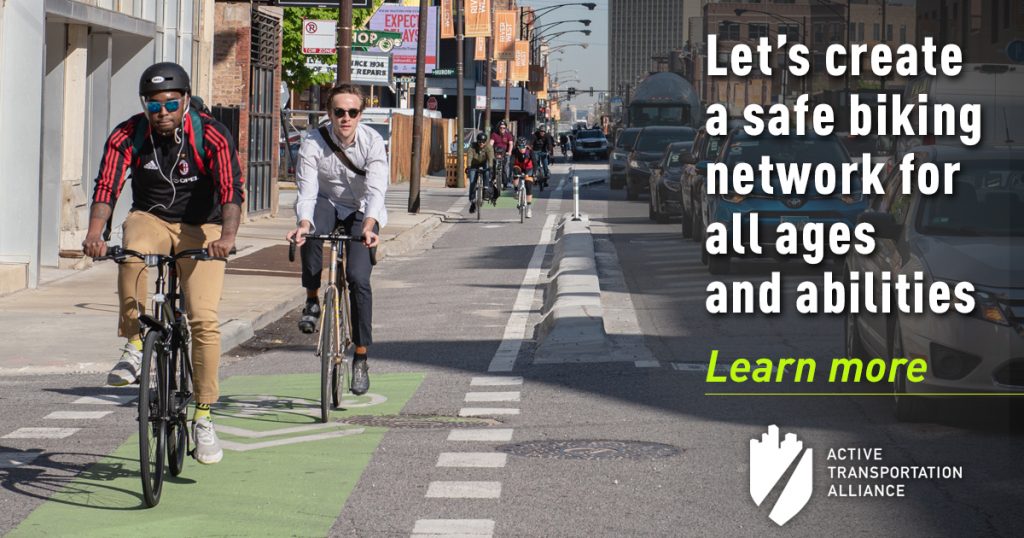Did You Know?
Chicago adds protected bike lanes, updates bike network strategy

Chicago announced what it’s calling the “biggest bike lane expansion in the city’s history” this week, saying the new lanes will improve resident health and safety and help build stronger, cleaner, and more resilient neighborhoods.
The news comes thanks to $17 million in new funding in 2021 and 2022 from Mayor Lightfoot’s Chicago Works capital plan. This will fund 100 miles of “new and upgraded” bike lanes over two years, including 12 miles of protected bike lanes.
Active Trans joined community and city leaders at a press conference celebrating the new protected bike lanes on 119th Street.
The lane — which runs between Ashland and Halsted and connects to the popular Major Taylor Trail — will increase access to jobs, grocery stores, open space, and other daily destinations.
The Chicago Department of Transportation (CDOT) also released a community cycling network update that highlights recently completed and planned projects, and lays out a path forward for growing the network.
HOW WE GOT HERE
For years Active Trans has pushed for Chicago’s budget to include dedicated funding for walking and biking infrastructure, with priority given to the highest need areas on the South and West Sides. The Chicago Works funds go a long way towards meeting this goal.
We have also fought for the city to build more high-quality bike infrastructure that’s safe and comfortable for people of all ages and abilities. We know physical separation from cars and trucks is what’s needed to truly increase safety and get more people riding bikes.
The 12 planned miles of new protected bike lanes (PBLs) represent a 50 percent increase in the number protected bike lane miles in the city. This is real progress and it’s the result of the relentless advocacy efforts on the part of supporters like you and our community partners in neighborhoods across the city.
MUCH MORE PROGRESS IS NEEDED
Everyone who rides a bike in Chicago knows we still have a long way to go.
Even with the 12 new miles, Chicago will only have about 37 miles of protected bike lanes on more than 4,500 miles of city streets. New York City added more than 120 miles of protected bike lanes in just six years. Minneapolis and St. Paul, Minnesota have more than 50 miles of PBLs.
Chicago is still too often compromising with painted bike lanes that have little impact on safety and won’t get nervous riders to hop on a bike. The need is greatest in South and West Side communities where streets are often supersized and lack critical safety infrastructure.
The new PBL projects and related strategy provide signs of hope that things are changing. The upfront community outreach CDOT did in the high-need areas of Austin, Belmont Cragin, and North Lawndale this year helped inform important new bikeways that will go in this year and next.
But this model needs to be taken to scale so we’re not thinking just one block — or even one neighborhood — at a time. We can’t keep settling for painted bike lanes. There’s still no clear strategy to build a citywide network that will get people riding bikes from point A to point B safely and comfortably.
A TRULY TRANSFORMATIVE CAPITAL PLAN
The Chicago Works capital plan provides an opportunity for the city to plan ahead and commit to doing the outreach and analysis needed to advance dozens of projects like the new PBL on 119th. To date, the capital plan has lacked the transparency and community accountability needed to make it truly transformative.
Instead, we continue to celebrate countless arterial resurfacing projects that do little to improve safety. City leaders keep locking the community out of key decisions that will determine the future of the city’s transportation network.
This week’s news shows things could be different if the city revamps its transportation planning processes and centers racial equity and environmental justice. Chicago is making progress on building bike lanes, bus lanes, and safer streets for all, but it’s too often drowned out by status quo, car-centric planning.
With your help, we’ll keep fighting to make city leaders accelerate this change and build a safer, healthier, cleaner, and more equitable transportation future for Chicago.
Top photo courtesy of the Chicago Department of Transportation.
Make a Donation
Your tax-deductible donation supports the important work that Active Trans does throughout the region

